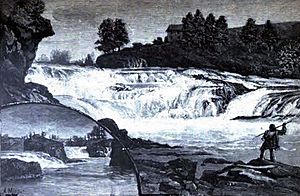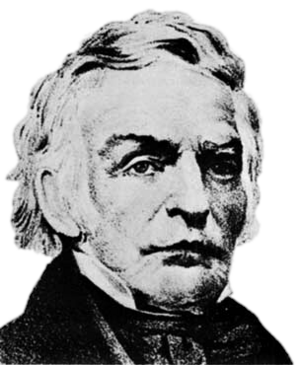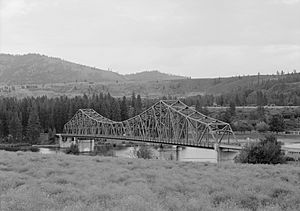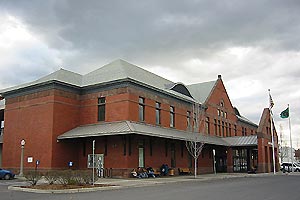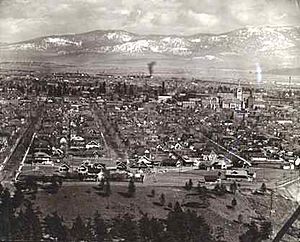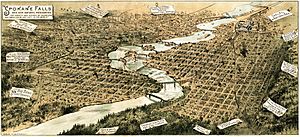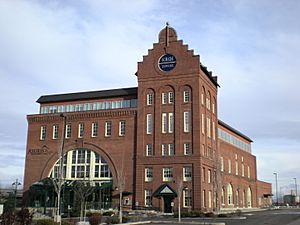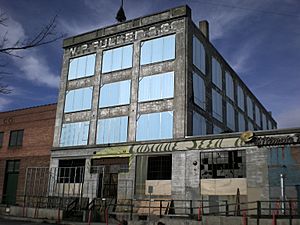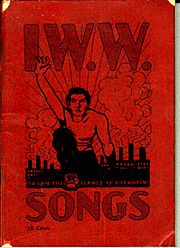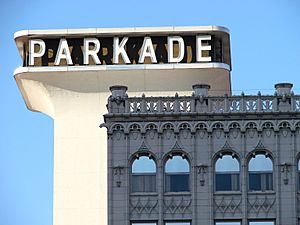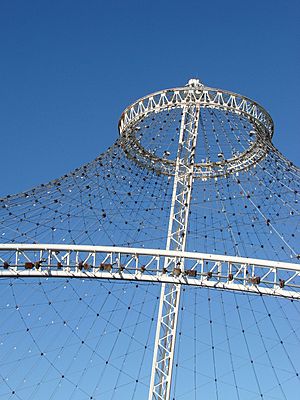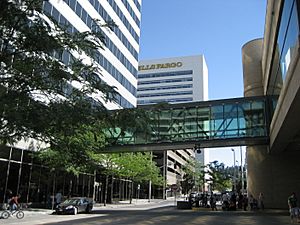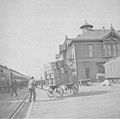History of Spokane, Washington facts for kids
The history of Spokane, Washington began thousands of years ago. The area around Spokane Falls was a meeting place for many different cultures. Native people settled here because of the good hunting grounds and lots of salmon in the Spokane River.
The first European to explore this area was David Thompson, a Canadian explorer. His team built a fur trading post where the Little Spokane River meets the Spokane River. This was the first lasting European settlement in Washington state.
American settlers, J.J. Downing and S.R. Scranton, built a cabin at Spokane Falls in 1871. In 1873, James N. Glover and Jasper Matheney saw how valuable the Spokane River and its falls were. They bought the land and a sawmill. They knew the Northern Pacific Railroad Company planned to build a railway through this northern area.
By 1881, the Northern Pacific Railway was finished. This brought many more European settlers to Spokane. With more railroads like the Union Pacific and Great Northern arriving, Spokane became a major business center in the Inland Northwest. It was one of the most important rail hubs in the western United States.
Spokane hosted Expo '74, the first World's Fair focused on the environment. It was the smallest city at that time to ever host a World's Fair. Later, the city's economy slowed down due to falling prices for silver, timber, and farm products. Spokane is now working to become more of a service-based economy. The opening of the River Park Square Mall in 1999 helped bring new life to downtown. This included building the Spokane Arena and expanding the Spokane Convention Center.
Contents
Early History (Before 1810)
First People in the Area
The Spokane Falls and the land around them were important to the native people for thousands of years. It was a great place to live because of the good hunting and many salmon in the Spokane River. The first humans arrived in the Spokane area between 12,000 and 8,000 years ago. They were hunter-gatherers who hunted animals like bison. Later, they also gathered roots, berries, and nuts, and caught fish.
The Spokane tribe, who gave the city its name, are believed to be descendants of these early people. Their name means "Children of the Sun" in their Salishan language. The Spokane Falls were a central place for trade and fishing for the tribe. The Spokane people shared their culture and language with other tribes like the Coeur d'Alenes and Kalispels.
In the early 1800s, two white fur trappers from the Northwest Fur Company met the Spokane tribe. The tribe thought they were special at first. But they soon realized the men did not bring "big magic," as tribe members still died from smallpox. A big smallpox outbreak in 1782 had already killed about half the tribe.
Growth and Settlement (1810–1890)
First Trading Post
David Thompson was the first European to explore the Inland Northwest. He worked for the North West Company. Thompson wanted to find more furs further south. In 1810, he sent two trappers, Jacques Raphael Finlay and Finan McDonald, to build a fur trading post on the Spokane River.
This post, called the Spokane House, was built where the Little Spokane River meets the Spokane River. It was the first lasting European settlement in Washington state. The Spokane House operated from 1810 to 1826. It was the main center for fur trading between the Rocky and Cascade mountains for 16 years. Later, the Hudson's Bay Company took over and moved most of the trading north to Fort Colvile.
In 1836, Reverend Samuel Parker visited the area. He reported that about 800 Native Americans lived at Spokane Falls. Later, Reverend Cushing Eells built the first church in Spokane in 1881. More churches followed in the early 1880s.
In 1853, Washington's first governor, Isaac Stevens, tried to make a treaty with Chief Garry and the Spokane tribe. As more American settlers arrived, tensions grew between the tribes and the settlers. This led to conflicts like the Yakima Indian War. Colonel George Wright ended these wars with victories at the Battle of Four Lakes and the Battle of Spokane Plains. His actions made the area safer for settlers.
American Settlers Arrive
The first American settlers in what is now Spokane were J.J. Downing and S.R. Scranton. They were cattle ranchers who settled at Spokane Falls in 1871. They built a small sawmill near the falls. In 1873, James N. Glover and Jasper Matheney from Oregon saw the potential of the Spokane River for water power. They bought the land and sawmill from Downing and Scranton for $4,000.
Glover and Matheney knew that the Northern Pacific Railroad Company planned to build a main railway line through this northern route. Matheney later sold his share to Glover. Glover held onto his land and became a successful businessman and mayor in Spokane. He is known as the "Father of Spokane."
Fort Spokane
In 1880, United States Army troops built Fort Spokane. It was located northwest of Spokane, where the Columbia River and Spokane Rivers meet. The fort was built to protect the building of the Northern Pacific Railway. It also secured the area for U.S. settlement. The fort helped keep peace between the settlers and the Spokane and Colville Indians. In 1882, President Arthur officially made it a military reservation and named it Fort Spokane.
The Railroad Transforms Spokane
By June 30, 1881, the railway reached Spokane. This brought many more European settlers to the area. The city was first called Spokan Falls and was officially made a city on November 29, 1881. It had about 1,000 residents. Robert W. Forrest was elected as the first mayor. James N. Glover, the "Father of Spokane," became the second mayor.
The city grew very quickly. Streets were built, and the small settlement became a busy city. The population jumped from 4,130 in 1881 to 19,922 in 1890. By 1910, it reached 104,000 people. The railroads brought settlers from places like Finland, Germany, England, and even Minnesota. Railroad companies advertised cheap, fertile land along their routes. This helped Spokane become the main business center of the Inland Northwest. It was known as the "capital" of the Inland Empire.
The Great Fire
Spokane's growth continued until August 4, 1889. A fire, known as The Great Fire, started just after 6:00 p.m. It destroyed the city's downtown business area. There was no water pressure to fight the fire due to pump problems. Firefighters tried to stop the fire by blowing up buildings with dynamite. Eventually, the winds died down. Thirty-two blocks of downtown Spokane were destroyed, and one person died.
Dutch Investment
Money to rebuild downtown Spokane came largely from Dutch bankers. European investors played a big role in Spokane's rebuilding. In 1883, Herman A. Van Valkenburg, a Dutch businessman, came to Spokane. He helped form a company that later became the Northwestern and Pacific Hypotheekbank in the Netherlands. This company helped rebuild downtown buildings using granite and brick instead of wood. By 1893, Dutch investors owned a quarter of the real estate in Spokane. They continued to help Spokane grow for many years.
Modern Spokane (1890–Present)
More Railroads Arrive

Even after the huge fire, Spokane quickly started rebuilding. The downtown area was rebuilt, and the city was officially renamed "Spokane" in 1891. New office buildings, banks, and stores were built. However, rebuilding was not always easy. Between 1889 and 1896, all six bridges over the Spokane River were destroyed by floods before they were even finished!
Just three years after the fire, in 1892, James J. Hill's Great Northern Railway arrived. It came to a new area called Hillyard (which later became part of Spokane). This was chosen for Hill's rail yards and shops. The new railroad brought another small population boom. Many homes were built for railroad workers, especially immigrants. Spokane also developed a large Asian community, mostly Japanese, in a district called Chinatown. These railroads made Spokane a major transportation hub for the Inland Northwest.
Spokane as a Business Center
With the arrival of the Northern Pacific and other railroads like the Union Pacific and Great Northern, Spokane became the business center of the Inland Northwest. Spokane's location between the Rocky Mountains and the Cascade Range made it an important rail and shipping hub. It connected mining areas (like Idaho's Silver Valley) and farming regions. Spokane became one of the most important rail centers in the western United States, with four major transcontinental railroads.
Mining Boom
In 1883, gold, silver, and lead were discovered in the Coeur d'Alene region. Mining became a huge boost for Spokane. The city became a popular place for miners to get supplies before heading out. Spokane was the best place for prospectors to buy everything they needed, from horses to frying pans, because of its lower prices and easy access by rail. During the mining boom, Spokane even had its own stock exchange, the Spokane Stock Exchange, which traded mining shares. Today, the Spokane area is still known as one of the most productive mining areas in North America.
Logging and Farming
After mining slowed down in the early 1900s, farming and logging became the main parts of Spokane's economy. The lumber industry started with the city's first business, a sawmill, built in 1871. Like mining, the lumber industry helped the economy by supplying lumberjacks and mill workers. The growing population and building of homes and railroads in the region fueled this industry. Spokane became known for making doors, window sashes, and other wood products.
The city also became important for processing and distributing dairy and fruit products. Spokane is still a major center for timber and agriculture in the Inland Northwest. By the early 1900s, Spokane was mainly a commercial center, not a big industrial one.
Growth Slows Down
Spokane grew quickly until the 1910s, when its growth suddenly stopped. The population even declined for a while. This was partly because control of regional mines and resources shifted from local owners to larger national companies. This meant less money stayed in Spokane. A sad event also affected morale: the collapse of the Division Street Bridge in 1915, which killed five people.
The 1920s and 1930s saw very slow growth. City leaders began to promote Spokane as a quiet, comfortable place for families, rather than a place full of new opportunities. Spokane's economy improved with World War II. Aluminum production started in the Spokane valley because of cheap electricity and the high demand for airplanes.
Free Speech Fights
During this time of slow growth, many unemployed workers faced problems with "job sharks." These were people who charged workers a fee to sign them up for jobs in logging camps. Sometimes, these agencies would cheat workers. Crime increased in the late 1800s and early 1900s. Unions like the Industrial Workers of the World (IWW), also known as "Wobblies," started "free speech fights."
In September 1908, the IWW purposely broke a city rule about public speaking. Many union members came to Spokane to join in. Many Wobblies were put in jail, including labor leader Elizabeth Gurley Flynn. She wrote about her experiences in the local Industrial Worker newspaper.
Birthplace of Father's Day
Spokane is famous as the place where the idea for Father's Day began. Sonora Smart Dodd came up with the idea in Spokane's Central Methodist Episcopal Church in 1909, after listening to a Mother's Day sermon. The first Father's Day celebration in Spokane was on June 19, 1910.
Revitalization Efforts (1960s and 1970s)
After many years of slow growth, Spokane businessmen formed a group called Spokane Unlimited. They wanted to bring new life to downtown Spokane. One early success was a new parking garage called The Parkade in 1965. The group then focused on improving Havermale Island, which was mostly old railroad depots. They wanted to create a park there to show off the Spokane Falls. They successfully moved the rail lines and freed up the island.
In the early 1970s, Spokane was nearing its 100th birthday. Spokane Unlimited decided to host a World's Fair. This led to Expo '74.
1974 World's Fair
Spokane hosted Expo '74, the first World's Fair with an environmental theme. It was the smallest city at the time to host a World's Fair. This event completely changed downtown Spokane. It removed the old railroad industry that had built the city and created a new city center. The Spokane clock tower was once part of a Great Northern Railway depot that was torn down for the fair. It is one of the biggest clock towers in the Northwest.
Many buildings from the World's Fair are still used today. The United States Pavilion is next to an IMAX theater. The Washington State Pavilion became the INB Performing Arts Center. The Expo site itself, on Havermale Island, became the 100-acre Riverfront Park. This park has the U.S. Pavilion, the historic Riverfront Park Looff Carousel, and the Great Northern Railway clock tower. The Chinatown district was also demolished during this time to make way for the Expo.
The late 1970s brought more growth to Spokane. This led to the building of the city's two tallest buildings in the early 1980s: the Farm Credit Banks Building and the Seafirst Financial Center (now the Bank of America building).
Recession and New Directions (1980s)
The success of the late 1970s was interrupted by another U.S. recession. Prices for silver, timber, and farm products dropped. This period of decline lasted into the 1990s. Many steady jobs in manufacturing were lost. However, Spokane's economy started to become more diverse. Companies like Key Tronic grew, and other technology companies opened research and assembly plants. This helped Spokane rely less on natural resources.
Spokane Today (21st Century)
Spokane is still working to become more of a service-oriented economy. The city is focusing on its strengths in medical and health sciences. This has led to the expansion of the University District with medical school branches from the University of Washington and Washington State University.
The opening of the River Park Square Mall in 1999 helped kickstart a downtown rebirth. This included building the Spokane Arena and expanding the Spokane Convention Center. Other big projects include the Knitting Factory concert house, and the renovation of historic buildings like the Montvale Hotel, the Davenport Hotel, and the Fox Theater (now home to the Spokane Symphony). Newer projects include the WSU Pharmaceutical and Biomedical Sciences Building and the Davenport Grand Hotel. Riverfront Park is also being renovated. The Kendall Yards development, west of downtown, is one of the largest construction projects in the city's history. It will combine homes and shops with plazas and walking trails.
Images for kids
-
The fertile rolling hills of the Palouse viewed from Steptoe Butte
-
Looking north. Shows IXL Clothing Co. at 425-7 Riverside Ave., and Old National Bank at Riverside Ave., northeast corner of Stevens in 1914.



